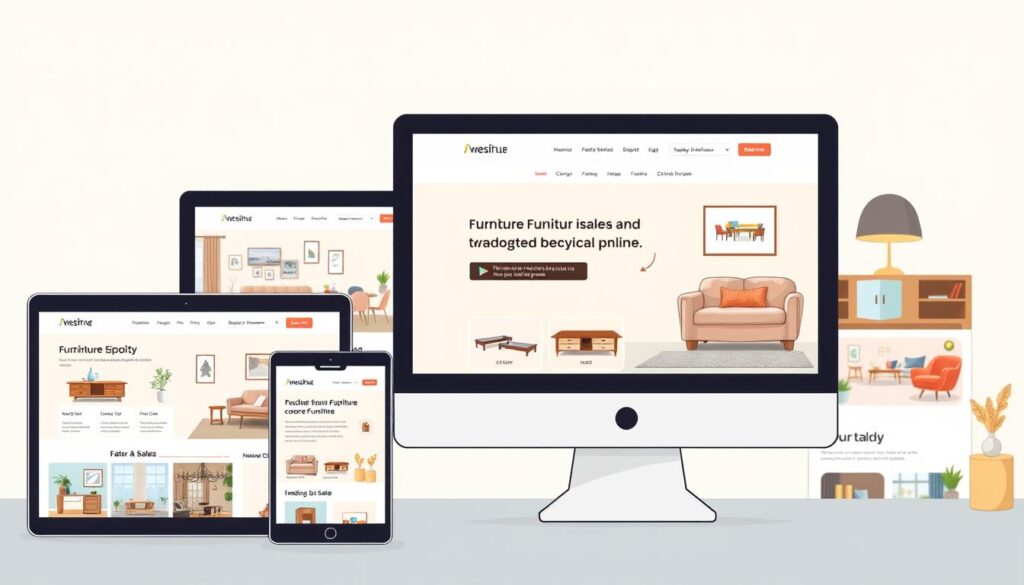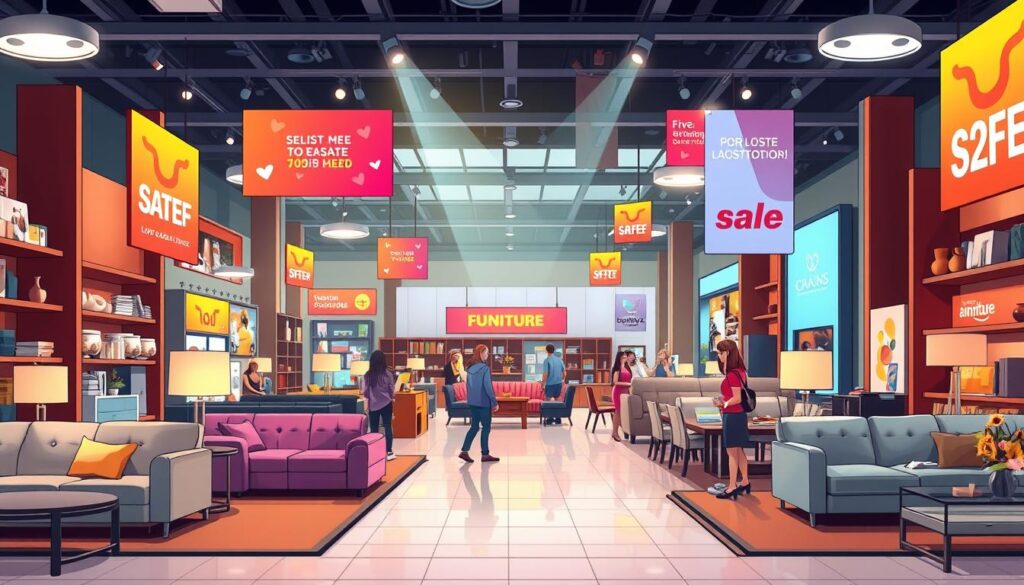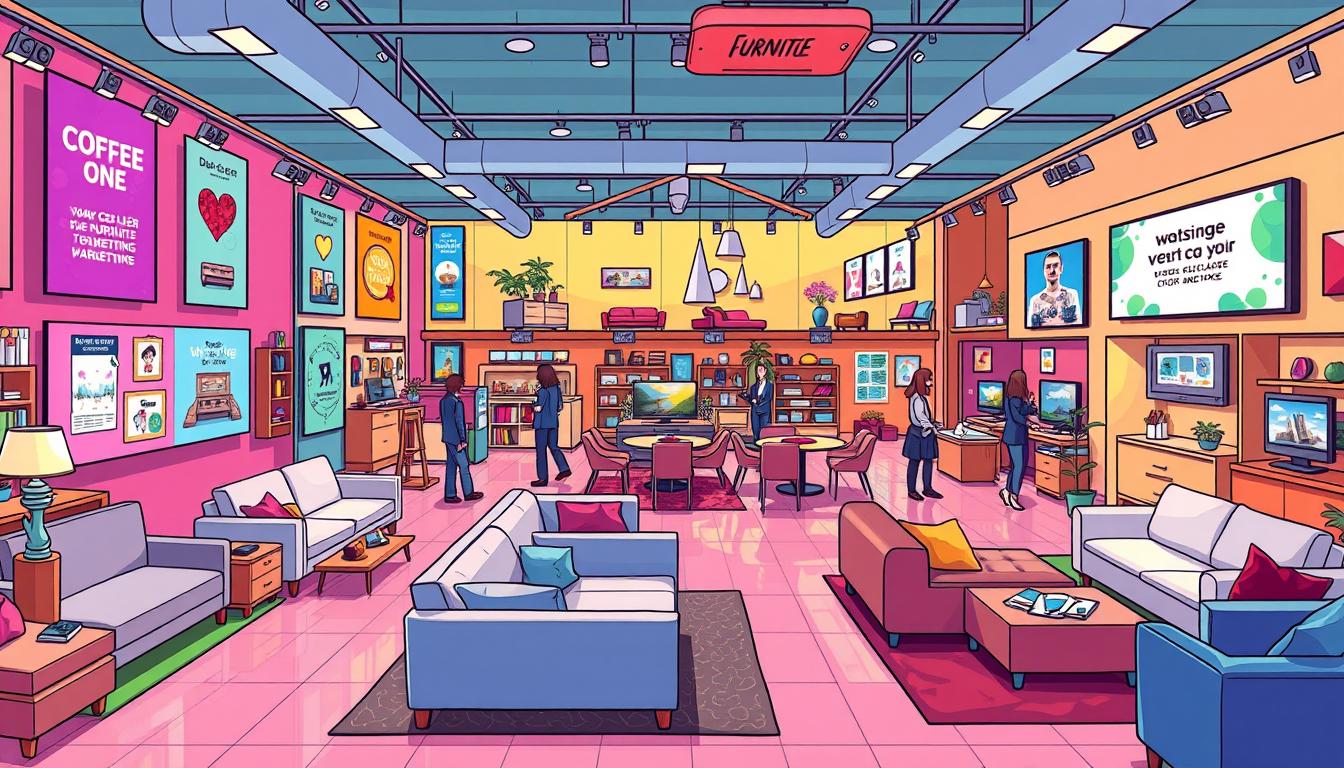Ever wondered why some furniture stores do great while others barely make it? It’s often because of their marketing for furniture stores plans. With online research playing a big role in 87 percent of showroom visits, it’s key to know good retail marketing strategies. This piece will dive into ways to boost your furniture ads and build a strong online presence in the home decor world.
By using the right strategies, your store can become the go-to place for customers. This leads to more sales and loyal customers.
Key Takeaways
- Up to 87 percent of customers research online before visiting a store.
- Retaining existing customers is more cost-effective than acquiring new ones.
- Social media is essential for promoting sales and discounts.
- High-quality images on websites inspire potential customers.
- Using PIM software helps manage marketing and product data efficiently.
- Millennials are predominantly active on Instagram and Pinterest.
- A full-funnel strategy on Facebook Ads can significantly enhance ROAS.
Understanding the Furniture Retail Market
For businesses, understanding the furniture retail market is key. It helps them improve their marketing plans. By studying what people want, they can meet those needs better.
Today, people want sustainable furniture and shop online more. They also value customer reviews. These trends help furniture stores know what to offer.
Key Trends Influencing Consumer Behavior
Online shopping is big, with 31% of U.S. shoppers buying furniture online often. Younger people, like Millennials and Gen Z, are driving this trend, making up nearly 70% of buyers. They care a lot about sustainable furniture.
Customer reviews are also very important. Many stores use platforms like Birdeye to manage reviews and improve their online image.
Competitive Landscape Analysis
Looking at competitors in furniture retail reveals important information. Brands like IKEA are known for their Scandinavian designs. Restoration Hardware attracts customers with beautiful social media content.
Stores like Wayfair make online shopping easy with great photos and detailed descriptions. Knowing these things helps businesses plan their marketing and grow their share of the market.
The furniture industry is always changing. To stay relevant, businesses need to keep up with trends. Augmented reality for virtual product views is a big plan for 52% of furniture companies.
Hosting in-store events, like Crate & Barrel does, builds loyalty and gets customers involved. These strategies help furniture stores meet today’s consumer needs and succeed.
Building a Strong Brand Identity
In the world of furniture retail, having a strong brand identity is key. It helps a business stand out among many choices. A good brand identity includes visual, verbal, and experiential elements. These all help people see what a brand is about.
Being consistent in all interactions builds trust and loyalty. This is crucial for a brand’s success.
Defining Your Unique Selling Proposition
A brand’s Unique Selling Proposition (USP) is at its core. It shows what makes a brand’s products special. This could be quality, design, or eco-friendliness.
Being clear about this uniqueness grabs attention and builds trust. Knowing who your customers are helps tailor your USP to them.
Crafting an Engaging Brand Story
Storytelling is vital in marketing. It connects with customers on an emotional level. A good story makes a brand relatable and memorable.
It shows a brand’s values and mission. Today’s customers want authenticity. A strong story can sway their choices. It also builds lasting relationships.
| Element | Description | Impact on Brand Identity |
|---|---|---|
| Visual Identity | The logo, color palette, and design aesthetics | Creates immediate brand recognition |
| Verbal Identity | Brand tone and messaging | Shapes the consumer’s perception and experience |
| Experiential Identity | The overall experience customers have with the brand | Builds trust and loyalty through consistent quality |
By focusing on brand identity and storytelling, furniture retailers can stand out. A strong brand identity boosts loyalty and perception in today’s market.
Leveraging Social Media for Engagement
Social media marketing for furniture brands is a great way to connect with customers online. It helps build a loyal customer base. Using popular platforms well can make your brand more visible and strengthen connections with buyers.
Popular Platforms for Furniture Stores
Furniture stores should pick platforms that match their target audience. Here are some key options:
- Facebook: It has over 1 billion daily users, perfect for interacting with customers and building a community.
- Instagram: Great for showing off furniture with high-quality images and shopping tags.
- YouTube: Best for sharing long-form videos and quick tips on furniture and home decor.
- Pinterest: Useful for interior designers and brands, letting users save and discover ideas.
- Houzz: A dedicated space for furniture sales and home renovation projects, appealing to homeowners.
- LinkedIn: Helps in building B2B relationships, especially for furniture brands targeting businesses.
Creating Shareable Content
To engage consumers online, you need creative content strategies. Content that speaks to your audience can boost visibility and engagement. Here are some ideas:
- DIY Projects: Inspire creativity with easy furniture projects for customers to try at home.
- Customer Stories: Share testimonials and real-life examples of how your products are used in homes.
- Decorating Tips: Provide practical advice to help customers see your furniture in their spaces.
- Contests and Giveaways: Engage audiences with interactive content that encourages participation and boosts brand awareness.
- User-Generated Content: Encourage customers to share photos of your products, creating authenticity and connection.
Investing in automation software can make managing social media easier. It helps track analytics and understand audience preferences. This allows for better marketing strategies and higher customer satisfaction.
Website Optimization for Increased Sales
Website optimization is key for furniture sales success. Many consumers research online before buying. So, knowing how to improve user experience is crucial. A good website keeps visitors engaged and boosts sales.
Easy-to-use navigation and attractive product displays are important. Quick websites are essential too. Slow sites can make users leave without buying.
User Experience Best Practices
Several strategies improve user experience:
- Intuitive Navigation: Easy menus and organized products help users find what they need.
- Visually Compelling Displays: Good images and clear descriptions sell products well.
- Clear Checkout Processes: Simple checkouts mean fewer abandoned carts and more sales.
- Personalization: Custom recommendations make users happier and more likely to buy.
Importance of Mobile Responsiveness
More people shop on mobile devices. So, having a mobile-friendly website is crucial. A responsive design ensures a great experience on any device. This brings many benefits:
- Improved Accessibility: Easy site navigation attracts more customers.
- Enhanced Rankings: Search engines like mobile-friendly sites, boosting visibility.
- Increased Engagement: A smooth experience keeps users interested and exploring more.

| Aspect | Impact | Result |
|---|---|---|
| Intuitive Navigation | Improves user journey | Lower bounce rates |
| Fast Load Times | Reduces frustration | Higher conversion rates |
| Mobile Responsiveness | Boosts accessibility | Increased customer retention |
| Clear Checkout Options | Minimizes cart abandonment | More completed sales |
Utilizing Email Marketing Effectively
Email marketing is a strong tool for furniture stores. It helps them talk directly to customers. Using targeted email marketing makes messages personal and engaging. This boosts sales and keeps customers interested.
Building a Targeted Email List
Having a good email list is key for email campaigns for furniture stores. Here are ways to grow your list:
- Use website pop-ups to ask visitors to sign up.
- Give special deals or content to subscribers only.
- Run social media campaigns to get more email sign-ups.
- Collect emails when people visit your store or attend events.
Segment your list to send more tailored messages. This makes your emails more relevant and effective.
Crafting Compelling Newsletters
Engaging newsletters keep customers in touch with your brand. A good newsletter should have:
- Great visuals of new items and deals.
- Design tips and trends.
- Personal offers based on what customers like.
- Seasonal content that fits the time of year.
Adding a sense of urgency and exclusivity can make your emails more appealing. Emails with good images get a 24.25% open rate and a 3.28% click-through rate. This shows how important visuals are.
Keep an eye on how your newsletters do. This helps you make them better and keep customers coming back.
By using targeted email marketing and making engaging newsletters, furniture stores can build a loyal customer base. This is crucial for growth in a competitive market. For more tips on reaching customers and boosting sales, check out this article.
Content Marketing Strategies
Effective content marketing is key for furniture stores to grow their brand and attract new customers. Blogging about home decor topics offers valuable insights and helps with SEO. This makes businesses more visible online.
Blogging for Brand Authority
Blogging is a vital part of content marketing. It helps engage the audience and build trust. With 65% of Americans expecting companies to use modern tech, an online blog is essential.
Regular blogging makes a business look like a leader in the industry. It also boosts visibility in search engines. Using keywords naturally in content helps improve online presence. For more on SEO, check out this resource.
Visual Content to Showcase Products
Visual content is crucial for showing off furniture products. High-quality images and videos help customers see how items fit in their homes. This can increase sales by up to 70%.
60% of consumers find new products on social media. So, vibrant visual content can reach more people. Using customer-generated content can also increase engagement and loyalty. It shows the brand values flexibility and customization, important to 68% of buyers.
| Strategy | Importance | Impact on Sales |
|---|---|---|
| Blogging | Establishes authority and enhances SEO | Increases organic traffic and brand visibility |
| Visual Content | Enhances customer engagement | Boosts conversion rates significantly |
| Social Media Integration | Reaches wider audience | Influences purchasing decisions effectively |
Local SEO Tactics for Furniture Stores
In today’s world, local SEO for furniture stores is key to drawing in nearby customers. Being more visible online can boost foot traffic and sales. Important steps include optimizing Google My Business and using local keywords.
Importance of Google My Business
Google My Business is vital for furniture stores to show up in local searches. By making your listing better, you can be seen more in local searches. Details like hours, location, and reviews build trust and help customers choose you.
Using Google My Business optimization helps you stand out in a busy market.
Targeting Local Keywords
Using local keywords is essential for SEO success. Finding and using keywords like “best furniture store in [City]” attracts local customers. Adding these keywords to your site makes it easier for nearby shoppers to find you.
Good content and local keywords together improve your site’s ranking. This leads to more interest and higher sales.
The Role of Paid Advertising
In today’s market, paid advertising for furniture is key. It helps brands reach more people than they would organically. By using targeted ads, businesses can show their products to new customers. This makes their marketing stronger.
Google Ads for Furniture Retail
Google Ads are great for getting more people to furniture websites. Brands can pick specific keywords to show up in search results. Google Ads offers text, display, and shopping ads for a full marketing plan.
To get the most out of Google Ads, keep an eye on how well it’s doing. This lets businesses make their ads better and get more people to buy.
Social Media Advertising Strategies
Social media ads for home decor are a great way to talk directly to customers. Sites like Instagram and Facebook let brands make eye-catching ads. They use videos to connect with people.
By focusing on specific groups, ads can be more effective. Adding fun stuff like interactive elements and influencer partnerships makes ads better. This builds trust and loyalty.

Creativity is key in making ads that people like. Successful furniture brands work hard on their ad copy. They also show off their green side to appeal to eco-friendly buyers.
Using paid ads well, along with organic efforts, can really help sales. It also keeps customers coming back.
Collaborating with Influencers and Bloggers
Influencer collaborations are key for brands wanting to grow and gain trust. By finding the right influencers, companies can make real partnerships. These partnerships help spread the word, drive traffic, and boost sales.
Identifying Suitable Influencers
Finding the right influencers for home decor takes strategy. Brands should pick influencers who share their values for a genuine partnership. They should look at engagement rates, audience demographics, and past collaborations.
For example, IKEA’s ambassador club used micro-influencers to great success. They got over 63 million views and saw a 11% increase in shop visits. This shows the power of choosing influencers who truly represent the brand.
Structuring Effective Partnership Campaigns
Brands need clear goals and mutual promotion in their campaigns. They should set metrics to measure success. Bassett Furniture teamed up with interior designer Jenni Holmes and saw engagement grow with each post.
Wayfair’s partnership with Kelly Clarkson doubled post engagement rates. This shows the value of working with famous people. Campaigns that focus on being real, like Tuft & Needle’s, can really make an impact and grab consumer attention.
Customer Loyalty Programs
Creating strong customer loyalty programs is key for furniture stores. These programs should reward customers for their purchases, referrals, or feedback. Good furniture stores use loyalty systems to keep customers coming back and make their shopping better.
Designing a Reward System
A good reward system gets customers to come back more often. For example, West Elm’s The Key gives 3% back on purchases. Ashley Furniture’s Orange Rewards lets customers earn points for future discounts.
These programs not only keep customers coming back but also make them feel special. Offering exclusive rewards, like early sales access or special discounts, makes these programs more appealing.
Benefits of Repeat Business
Loyalty programs do more than just boost sales. They help keep customers coming back. In fact, 81% of customers stay loyal to brands with loyalty programs.
Companies with loyalty programs see big wins in keeping customers. For example, Fab Home and Furniture saw an 80% jump in repeat sales. This led to a 2.4 times increase in revenue per customer.
Loyalty programs also give valuable insights into what customers like. This helps stores offer personalized shopping experiences. Personalized experiences lead to more engagement and repeat business.
| Furniture Brand | Program Features | Results |
|---|---|---|
| West Elm | 3% back in rewards on qualifying purchases | Enhanced customer satisfaction and engagement |
| Ashley Furniture | Points for future discounts | Increased repeat purchases |
| IKEA | Free coffee or tea for members | Stronger emotional connection with customers |
| Fab Home and Furniture | Loyalty program | 80% increase in repeat sales, 2.4 times revenue per customer |
| Zinrelo | Comprehensive loyalty management | 50% increase in profitability, 14 times retention |
Measuring Marketing Success
To measure marketing success, you need clear Key Performance Indicators (KPIs). For furniture marketing, important KPIs include website traffic, conversion rates, and social media engagement. These metrics help see how well your campaigns work and guide improvements.
Key Performance Indicators (KPIs)
Good measurement strategies focus on KPIs that match your business goals. For example, tracking customer acquisition costs and lead sources shows which marketing channels work best. Also, knowing customer behavior through web chat conversion rates and Google ratings helps improve your marketing and increase ROI.
Tools for Tracking and Analysis
Using strong analysis tools for marketing strategies is key. Tools like Google Analytics and social media insights help gather data. This makes it easier to see how well you’re doing. With these tools, furniture stores can make smart changes to their marketing, leading to better results.
Discover expert strategies for growthin the competitive market






